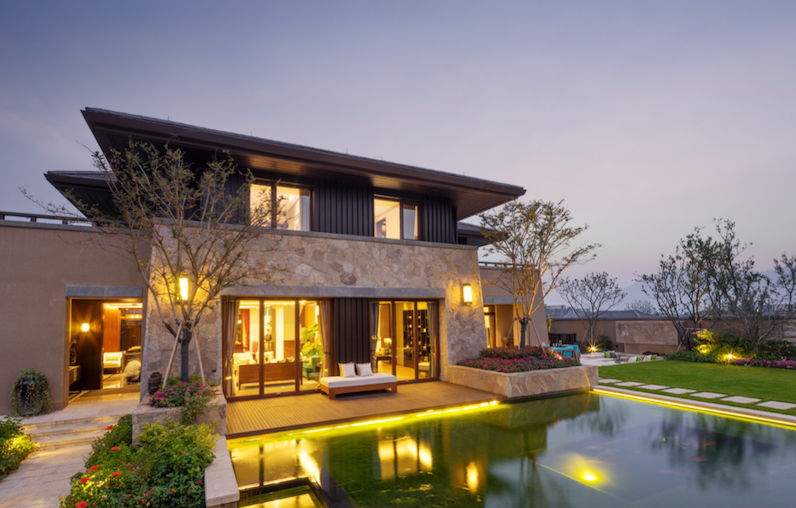Home: A house, apartment, or other shelters where an individual, family, or household usually resides. The place of one’s domestic affections. A person’s most personal items are stored at a house, and it is where a person feels secure and welcomed.
A home conveys a narrative and reflects a person’s or family’s interests. A home requires an emotional connection and a sense of belonging, not tangible items. A house may be a home, but a home cannot be a house.

Simply saying “Our houses are our safe havens, where we should feel secure and in command”.

Dream Home: What exactly is a dream home? A house where you feel at ease and have all the basics you needed.
People have different wants, and they want their dream house to meet their needs and future expectations within their budget. While building a house you think of many aspects but when we talk about a Dream Home the real concerns actually kick in.
Dream home is something extraordinary which no one would have ever thought of. Something that is extremely amazing and complete depiction of our thoughts, with which we can actually relate our emotions and feelings. You must have a vision of a dream house that you have developed or want to build.
If you don’t already own a home, it’s time to start thinking about it. Dreams are valuable if you work hard to make them real and apply them effectively. The first step in realizing the ideal house is to think about it gradually.
Here are five key pointers to consider while creating your dream home:
1. Budgeting: Understand What You Can Afford
Start Saving Money:

Is it possible to build a house without saving money? Certainly not. The first step in making the idea of building a house a reality is to save the necessary funds.
Dreams may become a reality if you start working on them. If you merely fantasize without a strategy, the home will never be built. Money is the most basic requirement for creating the ideal house, or we may say that attaining any ambition necessitates money.
As a result, there is a need to examine the budget and costs associated with the residence. To receive an appropriate budget for the project, consult an architect or a civil engineer. Begin saving money from your regular expenses with the purpose of developing and making a dream home.

Estimate your budget:
This is the least enjoyable aspect of house design, but it is necessary. Every other decision you make will be influenced by your budget. Custom house design costs can easily add up.
Throughout the design phase, you will almost certainly have to have difficult conversations about which Wishlist items are truly necessary, and which are not. You can expect to spend money on:
- Architect fees
- Building permit fees
- Inspections
- Site work
- Foundation
- Framing
- Interior and exterior finishes
- HVAC, plumbing, and electric
- Driveway and deck
When you are planning a budget, proper planning is required if you want to do it right. You must first assess your yearly or monthly revenue. Then, subtract your monthly costs from this revenue. Whatever is left over might be used to determine how much you are willing to set aside each month to pay for your house’s mortgage.
When budgeting, you should also consider the future. Determine if your spending will rise in the future and whether your revenue will rise. When you create a budget, make sure to inform your real estate agent so that you may find residences that are within your price range.
Set Your Building Budget:
Before you begin designing your ideal home or breaking ground on construction, you must first establish a construction budget.
Getting all of the builder’s loans and any finances you’re bringing to the table in order will help you to see how much money you have to work with.
Getting a loan or utilizing your personal funds to finance a new house development is common. If you’ve previously purchased land but lack the funds to construct your dream house, you can use it as collateral (a type of guarantee) to borrow money from a bank.
Once you have your funds, sit down with a professional and decide how you want to distribute and use your funds.
A word of advice? Make a small allowance in your budget for any unexpected costs so that you won’t have to panic if anything unexpected comes up.
2. Style and Type of your Dream Home:

The very first thing you should be certain about before diving into the interiors and decors is the style. Yes, understanding the architectural style is critical. What kind of residence do you want?
There are several home styles available today, including modern, contemporary, classic, and even some fusion and blended forms.
So, it might be difficult to know which direction to go at times, right? Do you see a more classic or modern design, for example?
Traditional architecture features towering, pointed roofs with gables and is composed of materials such as brick, wood, stucco, or stone. The windows are modest, but the colors are vibrant. Muted hues, big windows, and clean lines are common features of modern homes. They may employ materials such as reinforced steel or concrete.
The floor plan is another significant distinction. The space in a typical home is split into discrete, single-purpose rooms. Modern homes frequently have open floor layouts with fewer dividing walls and spaces that serve various functions. There are options other than classic and contemporary.
If you’re not sure what you want your house to look like, look into some of the most popular architectural styles for inspiration. Among these styles are:

- Contemporary
- Mid-century modern
- Cape Cod
- Colonial
- Country French
- Victorian Tudor
- Cottage
- Mediterranean
- Ranch
- Craftsman
- Farmhouse
Even if you’re unsure how to identify your chosen style, collect images of houses you like to show your architect and he can come up with best styles and types suiting you.
3. Home Location:

When deciding on a place for your dream house, the importance of location cannot be overstated. You have total control over ‘where you want to live,’ yet selecting a place is both mind-boggling and hard. The distance from your office, the location of your children’s school, and the availability of social services must all be considered.
4. Find the Right Dream Home for You:

This is when things start to get serious. You’re finally ready to start looking for a house after all your hard work saving money (and performing a lot of arithmetic, don’t forget). Woo-hoo!
But don’t lose sight of the goal. Make a list of elements that make a home match your budget, lifestyle, and ambitions, and keep to it throughout your house hunt. Here are some suggestions to get you started.
Connectivity:
The first and most important criterion when selecting a site is connection. Areas near roads and motorways provide convenient access to main portions of the city.
The proximity to vital commuting infrastructure, such as bus stops and metro stations, should also be considered. If your profession requires you to travel to other cities frequently, living near airports or train stations is a preferable option.
However, the price of a project frequently clashes with the connectivity benefits of its location. Properties in close proximity to motorways, motorways, and business areas are more expensive. Although, spending a little extra might provide you with significant long-term rewards.
Nearby Amenities:
If the nearest market is 15 kilometers away and you have to travel there every week for your groceries, the act may get tedious. So, before deciding on a place, search for fundamental amenities such as health care facilities, entertainment centers, retail malls, schools, and universities, among others.
There is no single location that can suit all of your needs. So, you should prioritize your demands and then select the neighborhood that best fulfils the majority of them.
City vs. Suburbs:
The debate over whether to live in a city or a suburb is an ongoing one. While big homes away from the city’s hectic population can be found in the suburbs, they are not a feasible alternative in terms of facilities.
The suburbs may lack contemporary conveniences such as commercial centers, lively marketplaces, and entertainment venues. They do, however, provide a more tranquil atmosphere than cities.
Don’t compromise on location and layout.
There’s nothing you can do about an out-of-the-way neighborhood or a strange design if you want to stay in this house for the long run. Look for a neighborhood and plan that will fit your lifestyle today and in the future.
Consider the school districts.
If you have or plan to have children, the quality of the local school systems is most likely on your mind. Even if you don’t have children or are retired, a property near outstanding schools may boost the value of your home.
Speaking of home value, look for a house that’ll grow in value:
Are housing values in the neighborhood increasing? Is the number of firms increasing? These variables might assist you in determining if your dream house will be a wise investment.
5. Documents Required to Build Your Dream House:
You cannot simply take up a shovel and start digging after you have gotten the necessary funds and land.
To build your house, you will need to secure various licenses from the local government, and your design and building proposal must adhere to Malaysian planning and building standards developed by the Ministry of Housing and Local Government (KPKT) and the Department of Town and Country Planning (JPBD).
A main submitting person (PSP) – either a professional architect, engineer, or building draughtsman – must develop and submit the building plans to the local government.
The four primary processes for permit applications and the authorities who will grant them are as follows:
Construction Permits Authority
- Application for land matters District Land Office/ Department of Land and Mine
- Application for planning permission Planning Department
- Application for building plans Building Department
- Application for Earthworks, road and drainage plans Engineering Department
Obtain the Certificate of Completion and Compliance (CCC) before moving in:
When your house is finished, you must receive this certification, which certifies that it is safe for occupancy. The CCC is one of the prerequisites imposed by the government to guarantee that newly erected structures meet the necessary standards.
It is issued by your PSP, and the CCC may be obtained only if the following six services have been confirmed:
- Confirmation for electricity supply.
- Confirmation of water supply from the state water authority.
- Proper connection for sewage treatment plant/mains.
- Clearance for lifts
- Fire safety confirmation from the Fire Department
Neighborhood:
The safety elements of a neighborhood and the lifestyle of its residents are examples of the quality qualities of a neighborhood. The neighborhood has real-life impacts on you are your family. Everyone has their own idea of what defines a “nice” neighborhood. Talk to your neighbors, learn about the neighborhood, and then proceed if you are confident in your decision.
Building a dream house is both exhilarating and daunting. It doesn’t have to be that way. Follow the steps above to simplify the process and guarantee that the end product is all you’ve hoped for.
Here at IQI Global, we can help you build the house of your dreams keeping all of these aspects ahead. So, what are you waiting for let’s surf together in the hunt of your dream home and find you best place to live in!
[hubspot type=form portal=5699703 id=85ebae59-f425-419b-a59d-3531ad1df948]

